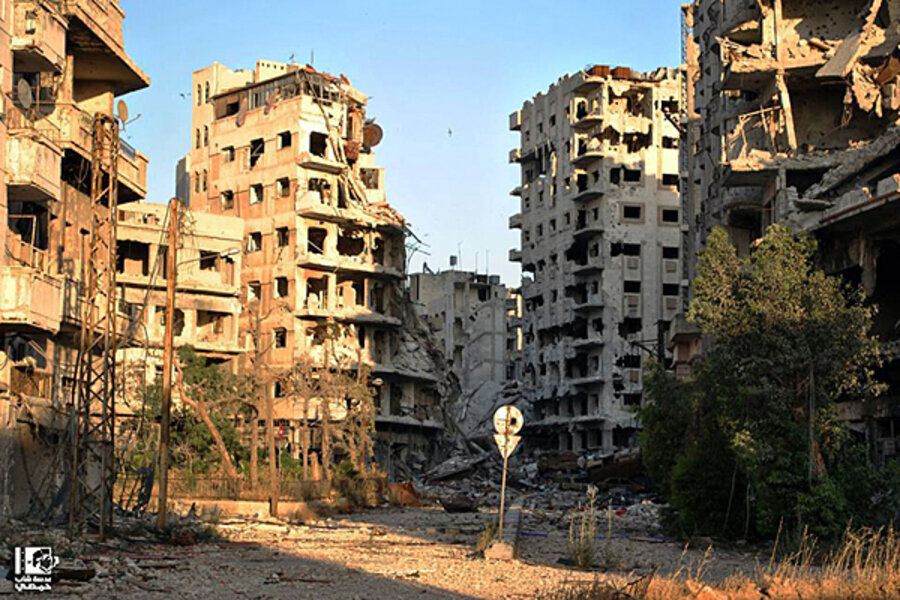‘Friends of Syria’ meeting adds pressure: What is US ready to do?
Loading...
| Washington
Secretary of State John Kerry attends a meeting of the Friends of Syria group in Qatar Saturday where the coalition of countries supporting Syria’s opposition forces – as well as the opposition forces themselves – await fresh details of US policy, following President Obama’s decision last week to begin arming the Syrian rebels.
The problem is, Mr. Obama is still weighing what steps to take and how far to go in aiding the opposition to Syrian President Bashar al-Assad, reflecting continuing deep divisions across the administration.
Representatives of the Free Syrian Army said this week that they would press at Saturday’s meeting for heavy weapons such as antiaircraft missiles and for imposition of a no-fly zone over parts of Syria.
The Assad regime has stepped up its use of aerial bombardments of rebel-held territory in recent weeks, a move that has helped shift the war’s momentum in Mr. Assad’s favor, some military analysts say. But the shift has also resulted in a spike in casualties among civilians and rebel fighters.
Some rebel leaders scoffed at Obama’s decision to begin providing weapons as “too little, too late” after some US officials said privately that the aid would initially consist of small arms and ammunition and perhaps some anti-tank weaponry.
But administration officials are cautioning against expectations of any announcements from Secretary Kerry specifying what lethal assistance the United States will be providing – or of any US decisions on more complex and consequential steps, such as creation of even a partial no-fly zone.
People should expect the Qatar meeting “more to be a discussion” of the ongoing “decisionmaking process” on aid to the rebels and “how we can all work together to better coordinate” that assistance, State Department spokeswoman Jen Psaki told reporters Thursday. Kerry “will be discussing, to the degree he can, what [Obama’s decision] means, how to coordinate that, and [the] other options that we’re considering moving forward.”
On Friday, Ms. Psaki appeared to go a bit further, telling reporters that Saturday’s meeting was likely to include a discussion on how to coordinate military aid from different countries and how to “change the balance” on the ground in Syria.
Also on Friday, a Free Syrian Army spokesman told CNN that “brotherly nations that support the Syrian revolution” were starting to provide the rebels with the anti-tank and antiaircraft weaponry they need to “change the rules of the war on the ground.” But rebel military leaders insist they are receiving nothing near the heavy weaponry they need, and they continue to call on the US to provide such weapons.
Obama’s decision last week was the result of a US determination that the Assad regime had used chemical weapons on several occasions in recent months against rebel populations, thus crossing a “red line” Obama set last year. Since then, White House officials have said that decisions on the how and what of future lethal assistance would be made at America’s own pace and would not be rushed by outside pressure.
"We've rushed to war in this region in the past. We're not going to do it here," Obama's chief of staff, Denis McDonough, said last Sunday on "Face the Nation" on CBS.
But part of the explanation for the administration’s lack of clarity on what Obama’s decision portends for Syria appears to be the ongoing divisions in the administration over just what the president should decide in terms of lethal assistance.
The option of imposing a no-fly zone over parts of Syria, along either the Jordanian border in the south or the Turkish border in the north, is one example of a divisive issue within the administration.
At a White House meeting last week on US “options” in Syria, the idea of a no-fly zone, along with the airstrikes that would be required to take out at least some of Assad’s air defenses to establish havens, was debated at length, administration officials say, but no decisions were made.
Kerry called for immediate airstrikes, arguing that the US should underscore the president’s veto on the use of chemical weapons by disabling the airfields that the Assad regime apparently used to launch chemical attacks. As a senator, Kerry supported military action against Assad.
But Kerry’s proposal was opposed at the meeting by Gen. Martin Dempsey, chairman of the Joint Chiefs of Staff, who argued that launching even limited airstrikes would be a complex operation and would probably entail deeper air involvement to disable Assad’s air defenses, administration officials say.
White House reluctance to go even further and establish a no-fly zone was made clear by Deputy National Security Adviser Ben Rhodes, who said in explaining the president’s decision to arm the rebels: "People need to understand that not only are there huge costs associated with the no-fly zone, not only would it be difficult to implement, but the notion that you can solve the very deeply rooted challenges on the ground in Syria from the air are not immediately apparent."
Some administration critics, among them members of Congress, cite what they see as Obama’s overly cautious approach to Syria and say they remain dubious that US lethal assistance will reach rebels anytime soon. They note that much of the nonlethal military assistance Obama agreed to provide earlier this year – communications equipment, vehicles, night-vision goggles – has still not reached the rebels.
The State Department says that more than half of the promised nonlethal military assistance has either reached the rebels or is on its way, while the rest is in a procurement pipeline that includes a required congressional notification process.








